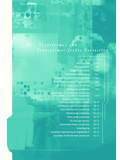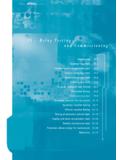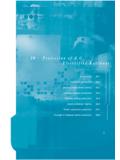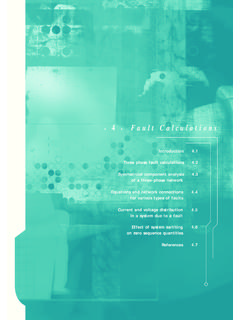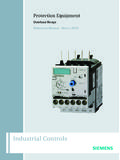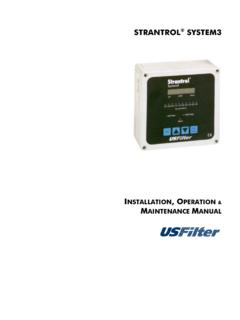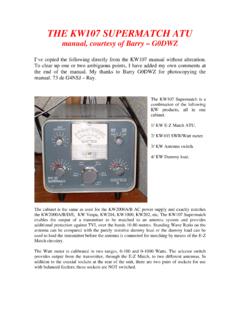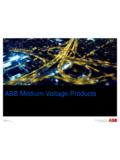Transcription of 13 Protection of Complex T ransmission Circuits
1 Introduction feeders feeders unit Protection feeders distance Protection feeders -application of distance Protection schemes of series compensated lines 13 Protection of ComplexTransmission INTRODUCTIONC hapters 10-12 have covered the basic principles ofprotection for two terminal, single circuit lines whosecircuit impedance is due solely to the conductors parallel transmission Circuits are ofteninstalled, either as duplicate Circuits on a commonstructure, or as separate lines connecting the same twoterminal points via different routes. Also, Circuits maybe multi-ended, a three-ended circuit being the economic reasons, transmission and distributionlines can be much more complicated, maybe havingthree or more terminals (multi-ended feeder ), or withmore than one circuit carried on a common structure(parallel feeders), as shown in Figure Otherpossibilities are the use of series capacitors or direct-connected shunt reactors.
2 The Protection of such linesis more complicated and requires the basic schemesdescribed in the above chapters to be purpose of this chapter is to explain the specialrequirements of some of these situations in respect ofprotection and identify which Protection schemes areparticularly appropriate for use in these PARALLEL FEEDERSIf two overhead lines are supported on the samestructures or are otherwise in close proximity over part 13 Protection of ComplexTransmission CircuitsNetwork Protection & Automation Guide 203 Figure : Parallel and Multi-ended feedersNetwork Protection & Automation Guide 204 13 Protection ofComplex Transmission Circuitsor whole of their length, there is a mutual couplingbetween the two Circuits . The positive and negativesequence coupling between the two Circuits is small andis usually neglected.
3 The zero sequence coupling can bestrong and its effect cannot be other situation that requires mutual effects to betaken into account is when there is an earth fault on afeeder when the parallel feeder is out of service andearthed at both ends. An earth fault in the feeder thatis in service can induce current in the earth loop of theearthed feeder , causing a misleading mutualcompensation unit Protection SystemsTypes of Protection that use current only, for exampleunit Protection systems, are not affected by the couplingbetween the feeders. Therefore, compensation for theeffects of mutual coupling is not required for the relaytripping the relay has a distance-to-fault feature, mutualcompensation is required for an accurate to Section for how this is Distance ProtectionThere are a number of problems applicable to distancerelays, as described in the following Current reversal on double circuit linesWhen a fault is cleared sequentially on one circuit of adouble circuit line with generation sources at both endsof the circuit, the current in the healthy line can reversefor a short time.
4 Unwanted tripping of CB s on thehealthy line can then occur if a Permissive Over-reach orBlocking distance scheme (see Chapter 12) is shows how the situation can arise. The CBat Dclears the fault at Ffaster than the CB at C. BeforeCB Dopens, the Zone 2 elements at Amay see the faultand operate, sending a trip signal to the relay for CB reverse looking element of the relay at CB Balsosees the fault and inhibits tripping of CB s Aand , once CB Dopens, the relay element at Astartsto reset, while the forward looking elements at Bpick up(due to current reversal) and initiate tripping. If thereset times of the forward-looking elements of the relayat Aare longer than the operating time of the forward-looking elements at B, the relays will trip the healthyline. The solution is to incorporate a blocking time delaythat prevents the tripping of the forward-lookingelements of the relays and is initiated by the reverse-looking element.
5 The time delay must be longer than thereset times of the relay elements at Under-reach on parallel linesIf a fault occurs on a line that lies beyond the remoteterminal end of a parallel line circuit, the distance relaywill under-reach for those zones set to reach into theaffected line. Analysis shows that under these conditions, because therelay sees only 50% (for two parallel Circuits ) of thetotal fault current for a fault in the adjacent line section,the relay sees the impedance of the affected section astwice the correct value. This may have to be allowed forin the settings of Zones 2 and 3 of conventionally setdistance the requirement for the minimum reach of Zone 2is to the end of the protected line section and the under-reach effect only occurs for faults in the following linesection(s), it is not usually necessary to adjust Zone 2impedance settings to compensate.
6 However, Zone 3 elements are intended to providebackup Protection to adjacent line sections and hencethe under-reaching effect must be allowed for in theimpedance Behaviour of distance relayswith earth faults on the protected feederWhen an earth fault occurs in the system, the voltageapplied to the earth fault element of the relay in onecircuit includes an induced voltage proportional to thezero sequence current in the other : Fault current distributionin double-circuit lineNetwork Protection & Automation Guide 205 13 Protection ofComplex Transmission CircuitsAs the current distribution in the two Circuits isunaffected by the presence of mutual coupling, nosimilar variation in the current applied to the relayelement takes place and, consequently, the relaymeasures the impedance to the fault the apparent impedance to the fault is greateror less than the actual impedance depends on thedirection of the current flow in the healthy circuit.
7 Forthe common case of two Circuits , Aand B, connected atthe local and remote busbars, as shown in Figure ,the impedance of Line Ameasured by a distance relay,with the normal zero sequence current compensationfrom its own feeder , is given by:..Equation :The true impedance to the fault is nZL1where nis theper unit fault position measured from Rand ZL1is thepositive sequence impedance of a single circuit. The'error' in measurement is determined from the fractioninside the bracket; this varies with the positive and zerosequence currents in circuit Aand the zero sequencecurrent in circuit B. M=ZM0ZL1ZA=nZL11+IB0IA0()M2IA1IA0()+K These currents are expressed below in terms of the lineand source parameters:ZM0= zero sequence mutual impedancebetween the two circuitsNOTE: For earth faults I1 = I0 All symbols in the above expressions are either self-explanatory from Figure or have been introduced inChapter 11.
8 Using the above formulae, families of reachcurves may be constructed, of which Figure istypical. In this figure, n is the effective per unit reachof a relay set to protect 80% of the line. It has beenassumed that an infinite busbar is located at each lineend, that is, Z S1and Z S1are both zero. A family ofcurves of constant n has been plotted for variations inthe source zero sequence impedances Z S0and Z can be seen from Figure that relay Rcan under-reach or over-reach, according to the relative values ofthe zero sequence source to line impedance ratios; theIB0IA0=n ZSO 1 n() ZSO2 n() ZSO+1 n() ZSO+ZL0+ZM0()IA1=2 n() ZS1+1 n() ZS1+ZL1()2 ZS1+ ZS1()+ZL1I1IA0=2 n() ZSO+1 n() ZSO+ZL0+ZM0()2 ZSO+ ZSO()+ZL0+ZM0I0andFigure : General parallel circuit fedfrom both endsFigure : Typical reach curves illustratingthe effect of mutual couplingextreme effective per unit reaches for the relay are 1.
9 Relay over-reach is not a problem, as thecondition being examined is a fault in the protectedfeeder, for which relay operation is desirable. It can alsobe seen from Figure that relay Ris more likely tounder-reach. However the relay located at the oppositeline end will tend to over-reach. As a result, the Zone 1characteristic of the relays at both ends of the feeder willoverlap for an earth fault anywhere in the feeder seeSection for more Protection can be obtained with a transfertrip, under-reach type distance scheme. Further,compensation for the effect of zero sequence mutualimpedance is not necessary unless a distance-to-faultfacility is provided. Some manufacturers compensate forthe effect of the mutual impedance in the distance relayelements, while others may restrict the application ofcompensation to the distance-to-fault function latter is easy to implement in software for adigital/numerical relay but is impractical in relays usingolder technologies.
10 Compensation is achieved byinjecting a proportion of the zero sequence currentflowing in the parallel feeder into the relay. However,some Utilities will not permit this due to the potentialhazards associated with feeding a relay protecting onecircuit from a CT located in a different the relay to measure the line impedance accurately,the following condition must be met:For a solid phase to earth fault at the theoretical reachof the relay, the voltage and current in the faulty phaseat the relaying point are given by:..Equation voltage and current fed into the relay are given by:..Equation :KRis the residual compensation factorKMis the mutual compensation factorVR=VAIR=IA+KRIA0+KMIB0 VA=IA1ZL1+IA2ZL2+IA0ZL0+IB0ZM0IA=IA1+IA2 +IA0 VRIR=ZL1 13 Protection ofComplex Transmission CircuitsNetwork Protection & Automation Guide 206 Distance relay behaviourwith earth faults on the parallel feederAlthough distance relays with mutual compensationmeasure the correct distance to the fault, they may notoperate correctly if the fault occurs in the adjacentfeeder.


